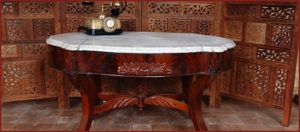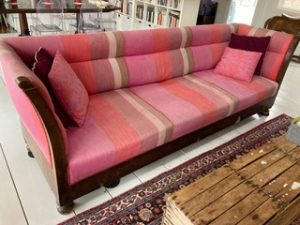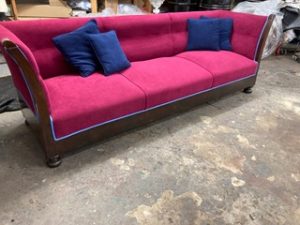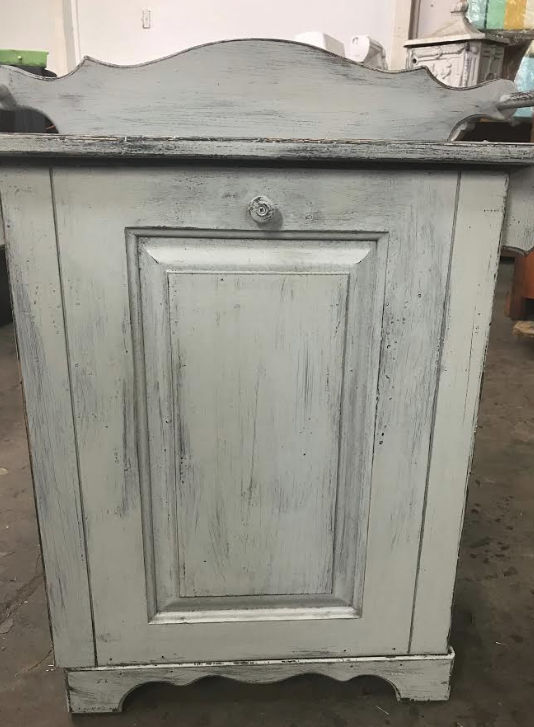
There are various types of woods used in antique furniture. Unlike modern furniture, antique furnishing was crafted with the best materials for their time. After all, mass production was not available. As a result, furniture was made to last. One of the ways to guarantee the quality of the product was through wood selection. The type of wood used in antique furniture can tell you a lot about the time period and intentions of the craftsman. So, what types of woods were used in antique furniture? Furthermore, what can this wood tell you about your antique piece?
One of the major appeals to antique furniture is wood. For generations, craftsmen would find the best quality material to create furnishings. As a result, a handful of woods were chosen. Some of these antique furniture woods include:
This is only a selection of woods that are found in older furniture. However, each of these woods holds historical and structural significance. Here is a brief history of some of these antique woods.
This hardwood originates from South Africa and the West Indies. Mahogony became very popular in Britain during the mid-18th century before it spread throughout Europe. The wood is known for its longevity, lasting for decades.
Furniture made of oak are known to be sturdy and solid, often being applied to carcass and drawer linings. It was most popular in the Georgian Era before seeing a revival in Victorian times.
Prior to the early 19th century, rosewood was for veneer and inlaid decoration. However, the wood’s unique dark color and fragrance made it perfect for furniture. The rosewood trade was so popular that it led to the tree’s near extinction.
As you can see, there are various types of wood used in antique furniture. As a result, special care needs to be taken when you are repairing or restoring this furnishing. At Foxwood Furniture Restoration, we specialize in furniture restoration. Our variety of services will help you restore your furnishing to its original condition! We even help recover furniture from water and fire damage!

What makes a piece of furniture valuable? Recently, Foxwood restored a beautiful Italian heirloom family couch at our Ann Arbor location. While furniture can depreciate over time, its value can vary depending on various factors. So, what makes furniture valuable?
Age tends to depreciate the value of items. Most of the time, this applies to furniture. However, there are some exceptions. As a rule of thumb, any piece of furniture that passes through two generations in fair condition starts increasing in value. What defines a generation? For Foxwood, a generation is loosely defined as 20 to 25 years. So, if a piece of furniture was made in the seventies or eighties, it started increasing in value in 2020! This value is also because furniture from that time period is of better quality than anything made today.
It might be hard to believe, but most furniture today is not made to a high standard. At least, not compared to a piece of furniture made 20 years ago. In fact, furniture made over 20 years ago is far superior to the furniture that you can find in the store today. Furniture can have tremendous value based on its materials, age, and creator. Furthermore, value can vary depending on the quantity and availability of a piece. Just like supply and demand, if there is less available then it’s going to be more valuable. It is also important to know that retail value does not translate as auction value. So, what makes a piece of furniture valuable is reliant on many factors. However, without a doubt, any piece of furniture over 20 years old is worth restoring!

Since 1994, Foxwood Furniture Restoration has specialized in furniture restoration including refinishing, repairs, stripping, sanding, and upholstery. We have a variety of services including smoke, water, and fire-damaged furniture repair! Foxwood has a professional and experienced team that is ready to tackle any job! So, contact Foxwood today for your furniture repairs and restorations.
Check out our blog for more interesting articles!

Are you looking for a furniture piece with character? A newly popularized furniture trend is the aged painted or wood with a distressed finish. In a state as full of history as Michigan, nothing is more beautiful than a distressed piece of furniture. Foxwood Furniture Restorations embraces this beauty.
A distressed finish, also known as aged painting, is used to make new furniture appear vintage and aged. In addition, distressed finishes are often created by making the paint seem worn. Aged painting is used to create a worn appearance to a new piece of furniture in colors besides the natural wooden coloring with brief glimpses of the original wooden base.
There are several distressing and aging techniques that Foxwood Restorations can do to make your furniture piece as beautiful as possible. Also, keep in mind that each distressed piece is different than the next. Each piece is unique. One particular distressing technique is called the wet-distressing technique. This is a popular technique when layering colors as it creates a naturally worn effect. Another popular technique is the dry-distressing technique which is best to use with single colors with a desire to expose the natural wooden layer. Lastly, the resist technique is used to create a chipping paint appearance meant to show antiquity.
If you are in or around Livingston County, you understand the value of Michigan’s history. Those living around the University of Michigan can practically feel the school’s history oozing from its foundations. Opened in 1817, The University of Michigan causes Ann Arbor to soak in past history. Foxwood Restorations will fix up student’s furniture for the best price whether that be repairs, distressing wooden furniture, or age painting furniture, Foxwood Restorations can do it all!
If you are interested in getting a new look for your furniture or getting a piece repaired, contact us! We are interested in bringing a new character to your house or school dorm! Finally, get your furniture repaired by the best, come to Foxwood Restorations. We cannot wait to hear from you!